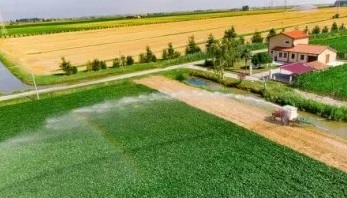The water requirement of the crops is defined complete amount and the method of water needed for a crop from the time it is planted to the time it is collected.

Different types of crops have different water requirements. It also depends on the condition of agricultural soil.
Every crop planted demands a certain amount of water at certain intervals of time throughout its growth period. If this demand is met by the rainfall at a sufficient amount, then there is no requirement for irrigation water. If not, irrigation is necessary to meet the demands of the crops. Crops require sufficient water at their required time in order to nourish and yield properly.
Each harvest planted requires a specific amount of water at specific timespans all through their development period. On the off chance that this interest is met by the precipitation at an adequate sum, at that point, there is no prerequisite of irrigation water. If not, the water system is important to satisfy the needs of the harvests. Harvests require adequate water at their necessary time so as to feed and yield appropriately.
Certain parameters that are necessary to calculate the water requirement of crops are described.
Table of Contents
Crop Period and Base Period
Crop Period
The time period from the plant of the crop to the instant of its harvesting is known as a crop period.
Base Period
The time period from the first watering of the crop during its sowing to the last watering of the crop before its harvesting is known as a base period. It is also known as the base of the crop.
Normally, the crop period is greater than the base period. Practically, both terms are considered the same and are expressed in days. In the calculation of water requirements of crops, the crop period, base period, and the growth period are considered the same and represented by ‘B’ in days.
What is the Duty and Delta of a Crop?
Duty of Water (D)
Duty is defined as the number of hectares of land that is irrigated for the complete growth of a crop by supplying 1-meter cubes per second of water continuously throughout the crop or base period ‘B’ of the respective crop. Duty gives a relation between the volume of water and the area of the crops that are harvested.
For example, 200 hectares per cumec to the base of B days means that the water flowing at a rate of 1 cubic per meter cube per second running continuously for B days, matures 200 hectares of crop.
Delta (Δ)
It is defined as the total depth of water required by a particular crop to attain its maturity condition. It is represented by delta in cm.
Every crop requires a certain amount of water at certain intervals throughout its period of growth. The time interval between such consecutive watering is called “Frequency of irrigation” or “Rotation period”. Every time, the water depth required by the crop varies from 5 to 10 cm which again varies with the type of crop. The rotation period can also vary in the range of 6 to 15 days depending on the type of crop.
Hence, the total depth of water required during the crop period represents the total quantity of water required for its complete nourishment. This total quantity of water required by the crop is measured in hectare-meter or acre-ft or million cubic meters or million cubic ft.
The concept of the delta can be explained by a small example.
If rice requires about 10 cm depth of water at an average interval of 10 days and the crop period of the rice is 120 days, Determine delta?
Crop Period, B = 120 days
Interval of watering = 10days
Number of Intervals demanded by the crop = 120/10 = 12 Intervals
The depth of water at each interval = 10cm
Delta = Total depth of water throughout the crop period = 12 x 10 = 120cm
Relation Between Delta and Duty
The relationship between duty (D) and delta (Δ) is given by the formula:

